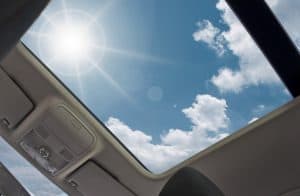How Safe is Your Sunroof?
 Sunroofs are panels on the roof of your vehicle—car, truck, or SUV—that slide open for light and airflow. The panel opens completely to allow for an open window on the roof, but is non-removable. Moonroofs are similar, but typically only tilt open to allow in air. As spring approaches in North Dakota and it finally starts to warm up, some of us may feel the urge to put these features in our cars to good use.
Sunroofs are panels on the roof of your vehicle—car, truck, or SUV—that slide open for light and airflow. The panel opens completely to allow for an open window on the roof, but is non-removable. Moonroofs are similar, but typically only tilt open to allow in air. As spring approaches in North Dakota and it finally starts to warm up, some of us may feel the urge to put these features in our cars to good use.
A recent report in the New York Times, however, has brought some safety concerns about sunroofs to light, especially in rollover crashes—even when the sunroof is closed. The NYT article reports that seven million, or 40 percent, of cars and trucks in 2017 came equipped with a sunroof or moonroof.
Sunroofs are linked to injuries
Sunroofs are a popular option on cars and trucks, yet there are no government regulations on them, even though there are hundreds of injuries and fatalities linked to sunroofs every year. According to the NYT article, the National Highway Traffic and Safety Association (NHTSA) reports that during a ten-year period, 300 people were killed and 1,400 were injured each year when thrown out of sunroofs in car accidents. And, victims were ejected through the sunroofs whether they were open or closed. The NHTSA did another, more focused, study of ejections through closed sunroofs only, and found that 230 people were killed and 500 were injured each year.
Even with reports of injuries and fatalities, there are still no mandatory regulations for automakers regarding sunroofs and moonroofs. You can even purchase a vehicle with a “panoramic sunroof,” which has a roof that spans the entire top of the vehicle. These can be even more dangerous during a car crash, especially if the glass isn’t laminated.
Tempered glass and the Hankins case
In the 2011 case of Hankins v. Ford, Marion Hankins and her family took Ford to court, alleging that her injuries from an accident resulted from a defective sunroof. Hankins was paralyzed in a single-vehicle crash after being thrown through the closed sunroof of her SUV. The accident also resulted in partial blindness and facial scarring. Evidence at the scene suggested that her vehicle rolled over, the glass on the sunroof popped out, and she was ejected from the vehicle through the hole in the roof.
Her lawsuit stated that the car’s manufacturer should have used laminated safety glass, which is the same material used to make car windshields. Her attorneys also alleged that Ford knew laminated glass was safer than the tempered glass they used to make sunroofs, but used tempered glass anyway because it was cheaper to manufacture.
Sunroofs remain without safety standards
The NHTSA’s data shows that there’s evidence sunroofs and moonroofs can be dangerous. However, there is still no set safety design or material for automakers. If and when lawmakers set mandatory standards, it’s likely laminated glass will be part of the discussion. Some automakers have already gone ahead and started using laminated glass for sunroofs on their newer models. Some manufacturers are working on designs for sunroof air bags. These features, however, are still optional.
If you suffered injury in an accident with a vehicle with a sunroof or moonroof, talk to the North Dakota car wreck attorneys at Larson Law We will fight to secure the compensation you deserve. To schedule your free initial consultation with an attorney, call our Minot office at 701-484-4878, or fill out our contact form.

Mark Larson is a Certified Civil Trial Specialist and Certified Civil Pre-Trial Specialist focusing on personal injury, car accidents, wrongful death, and oil field claims. Since 1979, Larson Law has served the injured throughout North Dakota. Read more about Mark V. Larson.
